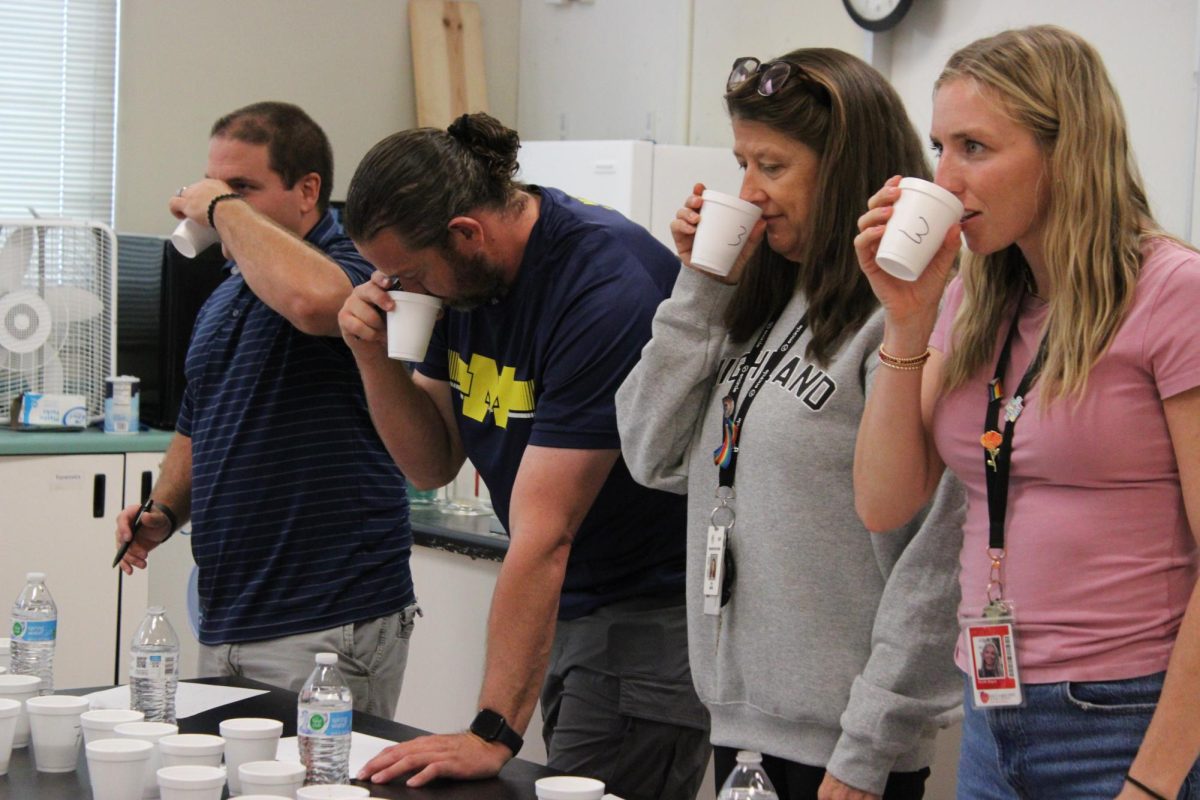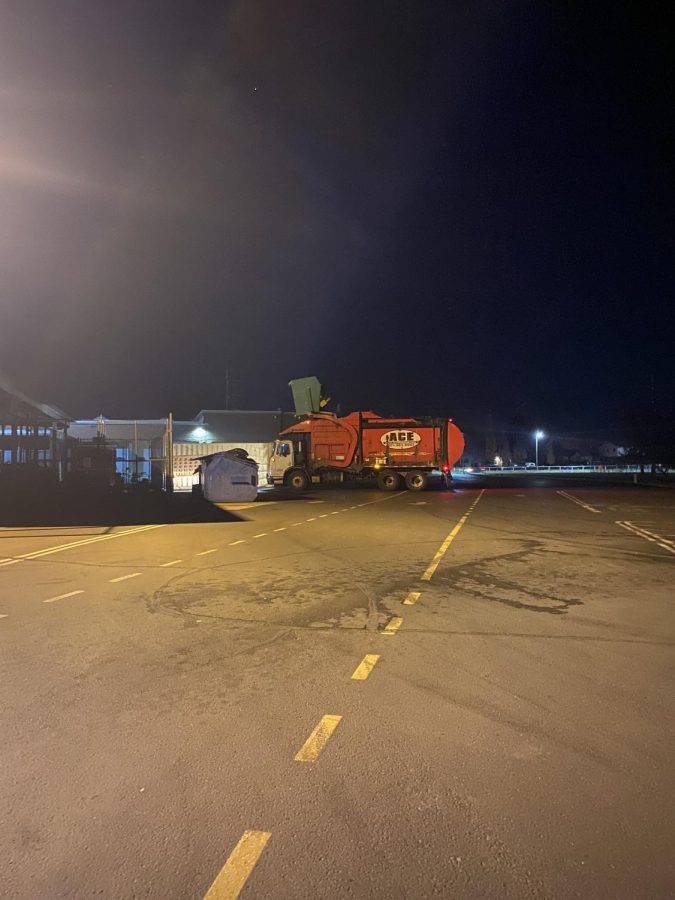Recycling at Highland is a Complex Problem
ACE Disposal picks up Highland’s recycling.
January 5, 2022
Those little Ziploc bags that are filled with sandwiches and chips in every students lunch box are great at keeping food fresh but they are spoiling the recycling efforts at schools everywhere.
And Highland is certainly one of the victims.

Ziploc bags are not recyclable. Worse, each time they are thrown in a recycling bin, they render all of bin’s contents unrecyclable because these little baggies are notorious for destroying recycling machines.
The recycling program at Highland has come under fire from teachers and students this year, mostly due to the practice of putting garbage and recycling bins into the same dumpster. Highland teacher Stephanie Watrin noticed this one day after school and immediately questioned why this is happening.
“I was here around 5:00, and when the girl that always cleans the floors waved me to bring my [garbage and recycling] cans out, I saw her dumping them in the same container,” Watrin said.
When Watrin asked the girl about mixing the garbage and recyclable materials, she was told that this was the new policy.
The Salt Lake School District recently passed a Clean Energy Resolution that set a goal to achieve 100% renewable energy by 2030 and 100% carbon neutrality by 2040. Not recycling seems like a move away from this goal. This is a sentiment that has been circulating around Highland lately, with many teachers and students expressing their concerns.
The frustrations quickly targeted the custodial staff at Highland, but the lack of recycling is not because after-school custodians are being lazy or simply refuse to recycle. Highland’s custodians are doing everything they can with very limited resources.
Highland actually has one of the best recycling programs in the district and is the top high school when it comes to recycling paper goods. But issues ranging from improper disposal of plastics and papers to staff shortages has made running a fully operational recycling program impossible.
STAFF SHORTAGES
A well-known fact this year is that Highland is crowded. And larger numbers of people create larger amounts of waste. Matt Lily, Highland’s head custodian, explained that his staff is doing the best they can to keep up with the growth but staffing shortages make it impossible to do all the work that is typically needed each day. Lily directs seven full-time employees and four part-time employees, which he said puts him about three workers short every day.
“When we have to keep up with all the day-to-day activities [of roughly 2000 students plus faculty and staff], then add recycling on top of it as a focus, it’s just so hard,” Lily said.
Like most industries, there are more jobs to fill than workers who apply and the custodial staffs at most schools are feeling the effects. Not only is Highland’s janitorial department understaffed, but there are labor shortage problems at the top of the recycling food chain as well.
Paper recycling is a different system from plastic recycling, and a different company deals with it. GreenFiber, a local Utah company that turns recycled paper into sustainable insulation for houses, also pays schools a monthly dividend based on how much material is collected.
GreenFiber doesn’t have enough truck drivers to meet the demand at most schools, especially large high schools, which, according to Lily, prohibits Highland from recycling everything. The dumpsters by the drivers ed. range fill up quickly with paper, then can sit for days on end until they are emptied. This leaves the custodians with no choice but to put the overflow paper straight into the landfill bin. Otherwise, piles of paper will just sit in the parking lot with nowhere to go.
Lily was adamant that if the trucks could come more often, Highland would be recycling almost twice as much paper. Because of this, the school could also be making considerably more money.
Currently, the modest sums received by the district go into schools’ discretionary funds, which are used for a variety of different purposes. For the time period from April-through-September, Highland earned nearly $400 for its paper recycling efforts – the top total in the district. Ideally, Lily said, these funds could go back directly into the recycling programs at schools, paying for more bins to make organization easier. This is something that Greg Libecci, Salt Lake School District’s Energy Resource Manager, is working on implementing.
But even if there were enough trucks to go around, there are often problems because of how recyclable products are thrown into bins.
IMPROPER RECYCLING
Reduce, reuse, recycle: those three words are usually the first thing children are taught about sustainability. Recycling is often painted as an easy measure that everyone can take that has a huge positive impact on saving the environment. There is very rarely any education past the very basic, when in reality the rules of what can be recycled are complicated and prone to change.
Most current recycling companies, including ACE Recycling and Disposal, where Highland sends its waste, only take No. 1 and No. 2 plastics.
Most students have no idea what materials are actually recyclable because there is very little education on the matter. Because of this, students are often flippant about what they put into the recycling bins, throwing food, partially full drink bottles, and Ziploc bags into a bin where they don’t belong.
Imagine a student buys a Gatorade from the vending machine. They drink most of it, then realize they shouldn’t have chosen the orange flavor. Thinking they’re doing a good thing, the student tosses the partially full bottle into the nearest recycling bin. Eventually when this bin reaches the recycling plant, the sticky liquid from the Gatorade bottle will leak out and possibly gum up a machine.
Contaminants like food, liquid, or unsuitable plastics, when mixed with usable recycling material, render the entire bin worthless and require that it be sent to the landfill.
“The recycling companies [Highland worked with prior to ACE] said they didn’t want it anymore, because there were too many plastic bags, food, and liquid, that actually ruined their machines. “
Rather than risk losing another contract, Highland’s recycling bins have been removed from many high-traffic areas to avoid these problems.
Now, the school recycles plastic on a smaller scale from bins in the faculty rooms. This is possible because fewer bins are more manageable for the custodians, as well as the fact that teachers do a better job of properly sorting their waste and recycling, Lily said.
However, as was noticed by Watrin one day she was chaperoning a school dance, there is a huge volume of plastic drink bottles that are just thrown into the trash by students, for lack of accessible recycling bins. This is especially true in the red hall by the vending machines, Highland might be able to collect many more usable plastics.
SOLUTIONS
First and foremost, Lily emphasized that it’s important to remember that Highland is the number one school for paper recycling in the entire district. Despite challenges, this school is successful in that area and doing its best to advance in others.
There are still several things that students and teachers can do to help improve the recycling system here at Highland, especially the plastic recycling.
“I believe the answer is student engagement,” Libecci said.
Students and teachers can work together to become educated on what materials can be recycled, and which bin each material is supposed to go into. They can also empty the plastic bins into the dumpsters in the parking lot in case the janitors aren’t able to do that.
These are simple steps to increase Highland’s plastic recycling, but they can still seem exhausting. Lily also emphasized the importance of reducing consumption from the source.
“Last year, we just learned a different way that we could teach without using so many materials,” Lily said, “then we came back this year, and teachers just started printing off packets and packets, using so much paper.”
Recycling is important, but it would be much easier to simply use fewer single-use materials in the first place. Working towards this goal, as well as sorting waste into the correct bins and helping to empty them into the correct dumpsters will help improve Highland’s recycling system and get the district closer to its goal of sustainability.
As was emphasized by Lily and Libecci, it is important for students to care about this issue and get involved. The easiest thing to do is for students to educate themselves on how to recycle properly and teach those around them. For example, an empty plastic water bottle is recyclable, but a chip bag is not.
Another thing that would be very helpful, according to Lily, would be for students to reduce the number of single-use plastics they use, removing the necessity to even sort out recycling. It is much more environmentally friendly to bring a reusable water bottle from home than try to figure out where to recycle a disposable one.
Lastly, Lily explained that students can encourage their teachers to adopt a three-bin system in the classroom—one bin for paper, another for mixed plastics, then finally one for trash. When this is in place, students can empty the bins themselves into communal dumpsters at the end of the day, making the custodians’ workload more manageable and increasing the likelihood of their materials actually being recycled.
Though some external problems will still exist, teenagers can play a large role in the success of their schools’ sustainability programs. The district is working on many ways to make schools greener, but effective progress can come from all levels, and recycling could be a good way to start this engagement.





























